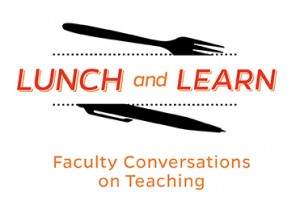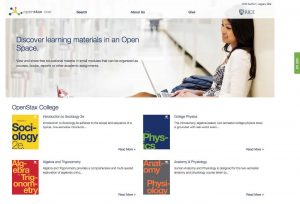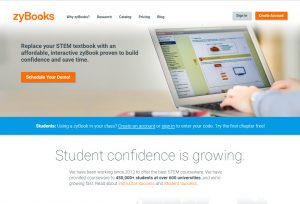On Wednesday, December 12, the Center for Educational Resources (CER) hosted the second Lunch and Learn for the 2018-2019 academic year. Shawntay Stocks, Assistant Director of Engaged Scholarship, Center for Social Concern; and Dora Malech, Assistant Professor, Writing Seminars; presented on Community-based Learning.
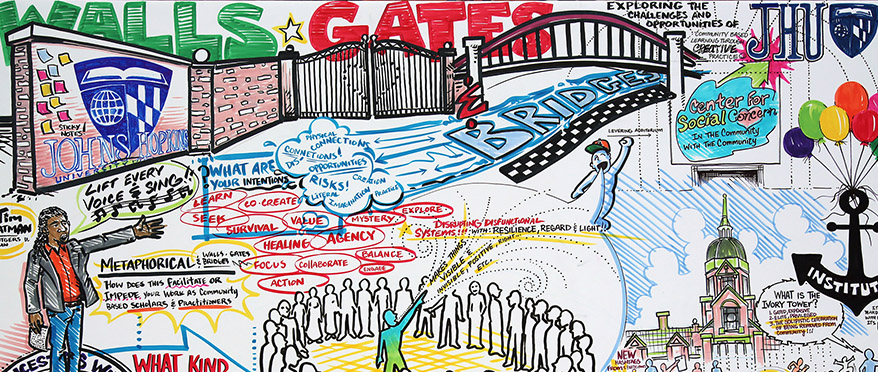
Shawntay Stocks opened with a presentation on community-based learning (CBL) at Johns Hopkins speaking about how her organization—the Center for Social Concern (CSC)—can assist faculty who wish to use the CBL pedagogical model in their courses (see slides here). The Center for Social Concern is the part of the Homewood Student Affairs division of Johns Hopkins University that focuses on volunteerism and community engagement; Community-based Learning is just one of their programs.
Stocks described CBL as “…a pedagogical model that connects classroom-based work with meaningful community involvement and exchange. Within the context of equitable partnership, community organizations and students mutually benefit from the CBL experience both by meeting course objectives and addressing community-identified goals. Students may engage with groups including, but not limited to: nonprofits, government agencies, grassroots collectives, and other educational institutions.” She noted that collaboration is the key for faculty, students, and community groups in pursuing mutual goals and course objectives, and that faculty must provide adequate preparation for their students to engage in CBL. The Center for Social Concern offers training for faculty, stipends to support faculty and community partners, and provides a TA for courses using CBL. At the core CBL is an equal partnership. The community partner may not have an advanced academic degree, but does have expertise, relationships, and contextual knowledge to bring to the table.
Students benefit because CBL allows them to connect theory to real-life experience and to think critically, in our case, about urban life in Baltimore. They have the opportunity to work collaboratively and collectively and gain an understanding of diverse perspectives. The skills they develop will be transferable to other aspects of their lives. Students often transform their thinking about the city in positive ways as they gain knowledge through reflection.
How can faculty ensure a successful CBL experience? Stocks emphasized the importance of “doing your homework” in terms of the community partner. You should think about these questions: What are the areas of commonality? How do your academic goals and their programmatic goals overlap? What are the expectations on both sides? What types of training will students need for a successful partnership? What are the logistics for partnership meetings? What commitment is being made (e.g., one semester, multiple semesters or academic years) and what is the potential for an ongoing partnership? What type of action are you planning for your CBL course—research, service, community building, advocacy, dialog?
Critical for the student experience are reflection and assessment. Reflection deepens learning. Instructors must allow for students to express their discomfort, frustration, anxiety, anger as well as their positive, affirmative feelings. It’s important to have conversations around the emotional impact of their experiences and acknowledge difficulties. Assessment of learning can be done through journaling, discussion, essays, or presentations.
At the end of the course there should be a project evaluation that includes the community partner. How did the partnership work? Were the learning goals accomplished? What would make the partnership work better? What were the pitfalls? How can these be navigated next time? CBL courses may be iterative processes and such evaluation will allow for continuous improvement of the experience for all involved.
Dora Malech won the Crenson-Hertz Award for Community Based Learning and Participatory Research from the Johns Hopkins University Center for Social Concern in 2016. For the past several years she has worked with CSC, partnering with the Writers in Baltimore Schools (WBS) program to give her Johns Hopkins Writing Seminars students a CBL experience. The WBS website has more information on this partnership. Malech shared her experiences with developing and teaching her course, Poetry and Social Justice.
Malech teaches undergraduate and graduate students now, but previously, at the University of Iowa, she directed a K-12 outreach program, which gave her an appreciation for community partnerships. In thinking about CBL, an important component for her is the concept of cultural humility, which comes from social work, a profession that emphasizes diversity and cultural competency. This idea of respecting the different experience of others and being open to learning from them works well for those interested in implementing CBL.
When she was first considering CBL, she made a lot of phone calls to prospective partners. Malech recommends meeting face to face, having coffee, getting to know the person. She ended up partnering with Patrice Hutton from the Writers in Baltimore Schools program. The program starts with Middle School students who participate in “in-school, after-school, and summer programming that builds skills in literacy and communication while creating a community of support for young writers.” Malech’s Writing Seminars students worked with Baltimore City high school students who had been program participants.
For the students on both sides, it is important to frame the relationship as a two-way transaction. The high school students have the experience of growing up in Baltimore City. They have cultural wealth and knowledge, and can articulate the community concerns. These students are college bound, but university culture is very much an abstraction for them. The JHU students may know nothing about inner-city life; the high school students give them the benefit of their urban experience, while the JHU students can help break down the mystery of what college life will be like for their high school partners.
Malech is explicit with her students about the course requirements. Participation in events outside of class time is mandatory—these include field trips, interview assignments, literary readings. Students are expected to get to these events on their own. Purchase of a Maryland Transit Administration CharmCard is recommended, and students should become familiar with public transportation such as local buses, light rail and the MARC train to DC. Due to logistics (the high school students are coming from all across Baltimore City), and to the high school students’ expressed preference, the class meetings are held on the JHU campus.
Malech said her role is to be explicit that the text is the community itself and that the students will build it together in the classroom. An on-going class blog—Poetry and Power—captures student writings. From the web site: “POETRY & POWER is the website and blog of “Poetry & Social Justice,” a Community Based Learning class that brings 15-20 Baltimore City high school students and 15- 20 Johns Hopkins University undergraduate students together to explore the intersection of poetry and social justice. They’ll write and read poetry together, engage with visiting writers, interview local poets and activists, and hold public performances of their own.”
As Stocks emphasized, Malech also views critical reflection as a key component for CBL. She uses the DEAL Model for Critical Reflection from Patti Clayton’s web site PHC Ventures (Mission: To build capacity for and generate best practices around community-engaged teaching, learning, and scholarship.), which Malech recommends as a great resource for those engaging in CBL.
A discussion followed the presentations. Stocks gave examples of different models of CBL. In one case a STEM faculty member and his class developed course modules to augment STEM programming at Margaret Brent Middle School. She fielded questions about whether it would be possible for Engineering capstone courses to use CBL with identified partners, specifically whether Civil Engineering students might partner with city agencies to identify and resolve infrastructure issues. This is an intriguing possibility that may be pursued with faculty and deans in the Whiting School of Engineering.
A question was posed about how to get departmental buy-in and funding for CBL courses. Malech noted that she had to prove that the concept was pedagogically sound and not overwhelming for the students. Strong positive feedback from the students showed that this was a high-impact teaching model. She said that she worked very hard to make the course a success. Getting positive publicity can be a strong incentive for department backing. Media attention acts as a “witness” to the process and as pressure for the administration to continue a project. She also presented at conferences and made the connection between strong writing and community engagement. Malech stated that culture change is an uphill battle where positive community feedback can really help. Being flexible and willing to scale up or down is important as well. The JHU President’s Office is advocating for community engagement, which may also be useful in getting departmental approval.
Stocks reminded us that CSC has resources for faculty and can assist even if someone wants to start on a small scale and build up to greater community engagement. Mike Reese, who uses CBL in his Sociology courses (focused on Baltimore City) noted that CSC had helped him get a JHU van to transport students for field work assignments. Stocks referenced the CSC website page for faculty wanting to use CBL—there are resources listed. She invited interested faculty to come have a conversation and learn more.
A question was asked about how a course could be restructured to include a CBL component. Faculty who have implemented CBL agreed that the activities must be the core course fabric. Traditional assignments can be swapped out for CBL assignments; class time can be used, or time outside of class can be substituted depending on the activity. Both the Center for Social Concern and the Center for Educational Resources can assist faculty with course planning.
Several participants who have used CBL in their courses stressed the importance of structuring and scaffolding the experience for students to assure that they buy into the concept. Malech emphasized that students should be prepared for the fact that there will be a certain amount of chaos inherent in the program, and that interpersonal relationships can be challenging. That is part of any real-world experience, but if students are prepared, they will be able to adapt. Another faculty CBL user noted that it is never a majority of students who feel “unsettled” by the realities of city life and partnership, but for those who are it is important to keep communication lines open and be flexible. And someone else noted that the “chaos factor” is also part of the equation for faculty and doesn’t go away even after multiple experiences offering CBL courses. In her experience, the chaos is well worth the meaningful, long-term impact for students. Malech commented, “That’s what college should be all about.”
Ahmed Ibrahim, Senior Education Research Consultant in the Center for Educational Resources, has been analyzing data on CBL courses taught at JHU from 2015 to 2017. He shared that students indicated that the best aspect of CBL courses is the personal interaction. Students asked for negative aspects made comments when the course was not well-structured.
Mike Reese, Director of the Center for Educational Resources asked Stocks and Malech what the best thing about CBL has been for them. Stocks answered that she enjoys creating CBL partnerships and wants to further engage faculty in a CBL learning community. For Malech, it has been the publishing and presenting as an educational expert outside her field of poetry. In terms of the learning process, she has come to think differently about course content. While originally she was focused on social justice and lived experience for the high school students, they challenged her to allow them to be creative writers. She’s appreciated the chance to be more open about her own assumptions of what the community partner wants and needs.
Macie Hall, Senior Instructional Designer
Center for Educational Resources
Image Sources: Center for Social Concern, Community-based Learning web site: https://studentaffairs.jhu.edu/socialconcern/programs/community-based-learning/
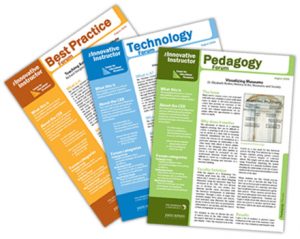 After 31 years at Johns Hopkins University, 11 in the Center for Educational Resources, six years and 198 posts on The Innovative Instructor, I am retiring. The good news is that my colleague, Amy Brusini, will be taking on the mantle, not only as the new editor of this blog, but as the Senior Instructional Designer in the CER.
After 31 years at Johns Hopkins University, 11 in the Center for Educational Resources, six years and 198 posts on The Innovative Instructor, I am retiring. The good news is that my colleague, Amy Brusini, will be taking on the mantle, not only as the new editor of this blog, but as the Senior Instructional Designer in the CER.

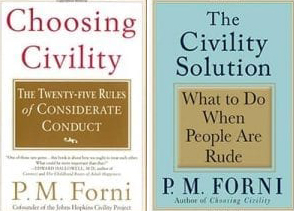 Dr. Forni was the co-founder of the
Dr. Forni was the co-founder of the  While tracking down some resources for active learning this past week, I stumbled on
While tracking down some resources for active learning this past week, I stumbled on 

